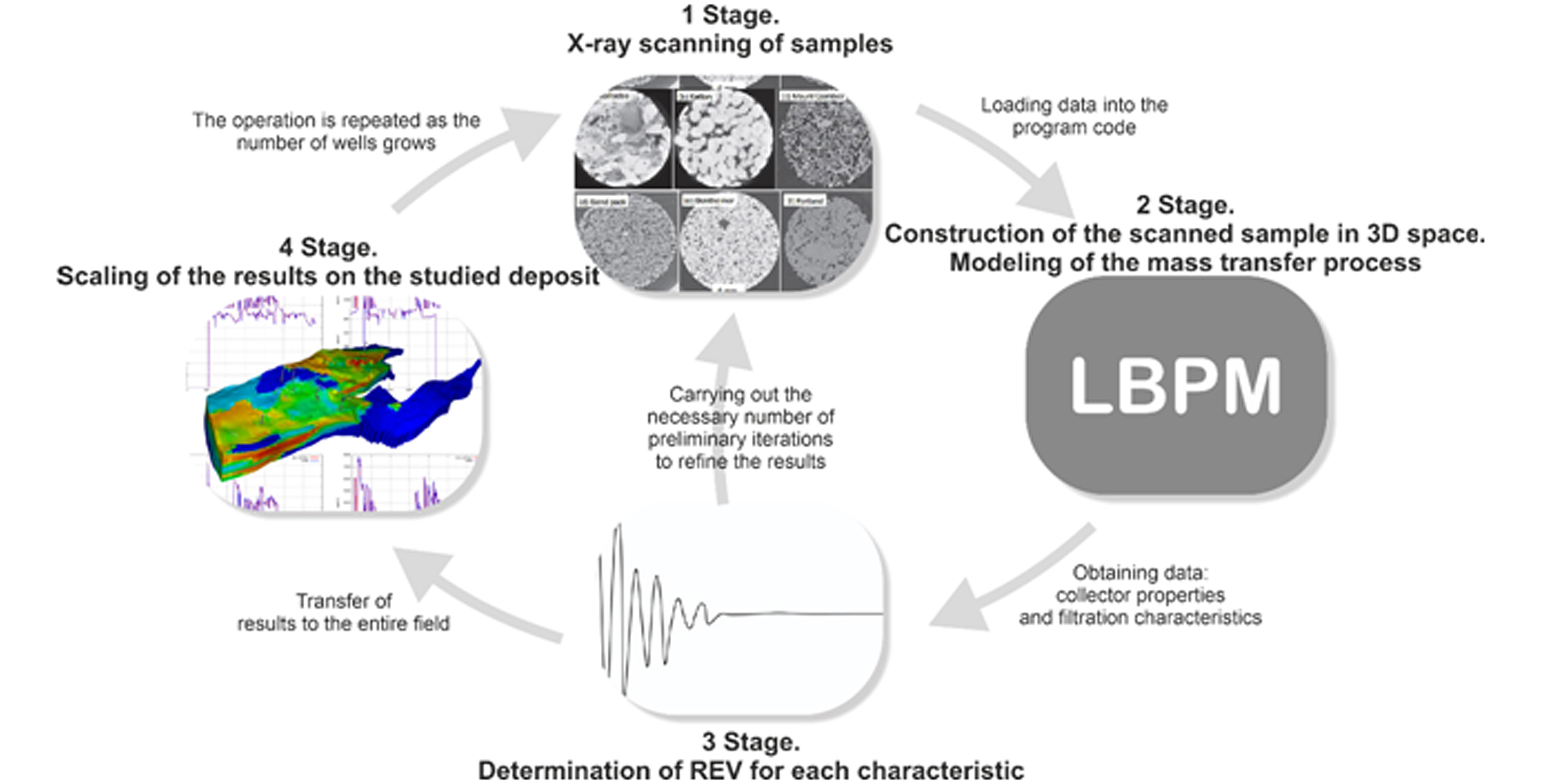Development of improved method for evaluation of reservoir properties of formation
DOI:
https://doi.org/10.15587/2706-5448.2022.266572Keywords:
fluid transfer, porous media, pre-alfa version, reservoir rock, uncertainty degreeAbstract
The object of research in the paper is the process of fluid transfer through the pore space of the reservoir rock. The traditional method of assessing reservoir properties has a significant number of sources of uncertainty. In this article, to compensate for the shortcomings of the existing method of reservoir characterization, an algorithm of actions is proposed with an increase in the accuracy and representativeness of its results.
The workflow of the pre-alpha version of the software for the existing pore space representation algorithm is presented. In this work, the step-by-step actions necessary to create an application that can reproduce the pore space and mass transfer processes in it by reading the data of the magnetic resonance imaging (MRI) of the rock were analytically determined. In particular, the use of ready-made open code is proposed, which displays the rock according to the pictures and also reproduces the fluid flow processes in the rock reservoir. Still, there is no adapted framework for the ordinary user.
The use of such an application, proposed by the authors, will lead to a much lower degree of the reservoir properties uncertainty, will help to more reliably reflect the reservoir properties of the reservoir rock, and provide a more reliable impression of the reservoir operation at the design stage of its development.
The proposed software, based on already existing developments in open access on the GitHub platform, will help the user to fully use the existing tools for building a three-dimensional model of a porous sample based on the data of MRI images of the rock.
After finalizing the user interface with the help of the user interface design and front-end development, the engineering staff will be able to conduct research on the rock at a macroscopic level.
References
- Martus, O., Petrash, O. (2022). Improved methodology development for assessing the reservoir collector properties by the quantitative reservoir characterization tools. Technology Audit and Production Reserves, 4 (1 (66)), 42–46. doi: https://doi.org/10.15587/2706-5448.2022.263640
- Blunt, M. J. (2017). Multiphase flow in permeable media: A pore-scale perspective. Cambridge university press, 56–72. doi: https://doi.org/10.1017/9781316145098
- Fang, X., Zhang, J., Liu, T., Zhang, Z., Li, F. (2022). New prediction method of horizontal principal stress of deep tight reservoirs. Scientific Reports, 12 (1). doi: https://doi.org/10.1038/s41598-022-16954-1
- LBPM Homepage. Available at: https://github.com/OPM/LBPM Last accessed: 20.10.2022
- Unsal, E., Rücker, M., Berg, S., Bartels, W. B., Bonnin, A. (2019). Imaging of compositional gradients during in situ emulsification using X-ray micro-tomography. Journal of Colloid and Interface Science, 550, 159–169. doi: https://doi.org/10.1016/j.jcis.2019.04.068
- Wang, Y. D., Blunt, M. J., Armstrong, R. T., Mostaghimi, P. (2021). Deep learning in pore scale imaging and modeling. Earth-Science Reviews, 215, 103555. doi: https://doi.org/10.1016/j.earscirev.2021.103555
- Taylor, H. F., O’Sullivan, C., Sim, W. W. (2015). A new method to identify void constrictions in micro-CT images of sand. Computers and Geotechnics, 69, 279–290. doi: https://doi.org/10.1016/j.compgeo.2015.05.012
- Jacob, A., Enzmann, F., Hinz, C., Kersten, M. (2019). Analysis of Variance of Porosity and Heterogeneity of Permeability at the Pore Scale. Transport in Porous Media, 130 (3), 867–887. doi: https://doi.org/10.1007/s11242-019-01342-7
- Ringrose, P., Bentley, M. (2016). Upscaling Flow Properties. Reservoir model design. Berlin: Springer, 115–149. doi: https://doi.org/10.1007/978-94-007-5497-3_4
- Digital Rocks Portal, Bentheimer micro-CT with waterflood. Available at: https://www.digitalrocksportal.org/projects/172/sample/178/ Last accessed: 24.10.2022
- Catalog NGC Nvidia. LBPM. Available at: https://catalog.ngc.nvidia.com/orgs/hpc/containers/lbpm Last accessed: 24.10.2022
- Vislt Homepage. Available at: https://visit-dav.github.io/visit-website/ Last accessed: 24.10.2022

Downloads
Published
How to Cite
Issue
Section
License
Copyright (c) 2022 Olena Martus, Viktor Agarkov

This work is licensed under a Creative Commons Attribution 4.0 International License.
The consolidation and conditions for the transfer of copyright (identification of authorship) is carried out in the License Agreement. In particular, the authors reserve the right to the authorship of their manuscript and transfer the first publication of this work to the journal under the terms of the Creative Commons CC BY license. At the same time, they have the right to conclude on their own additional agreements concerning the non-exclusive distribution of the work in the form in which it was published by this journal, but provided that the link to the first publication of the article in this journal is preserved.







